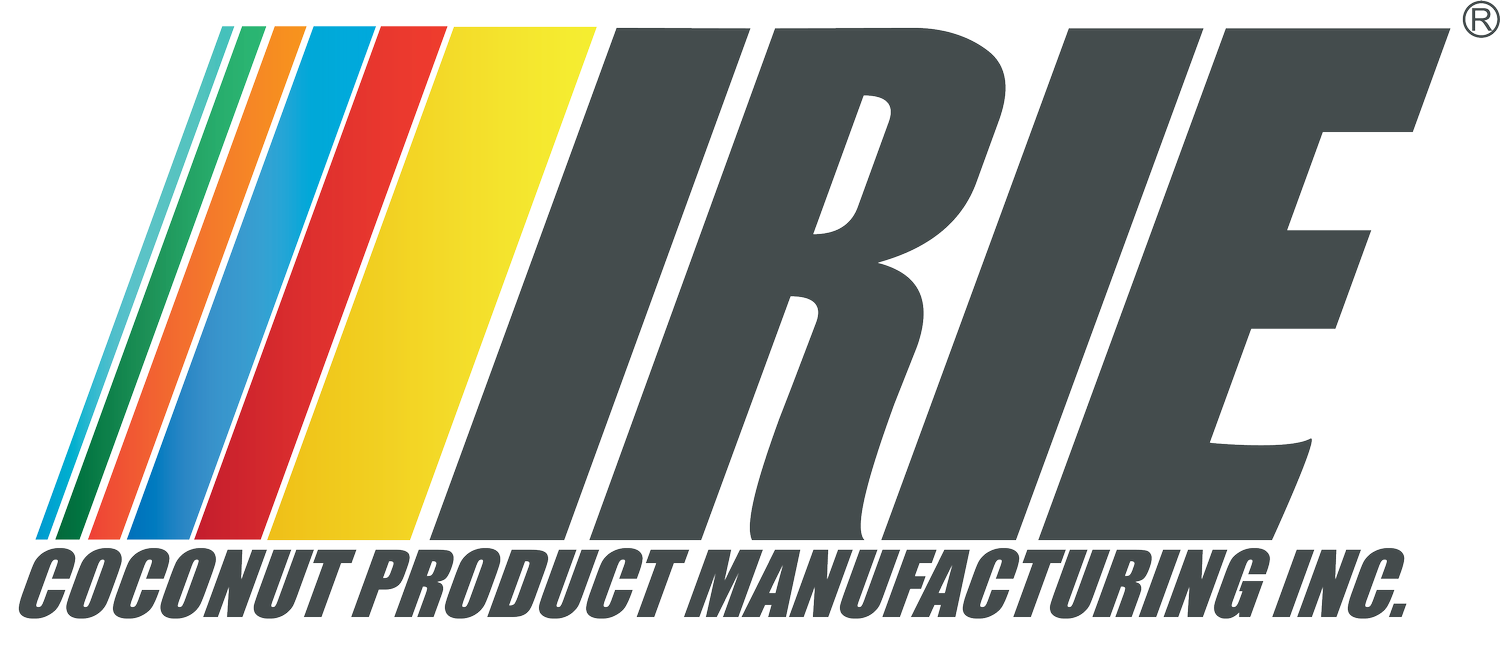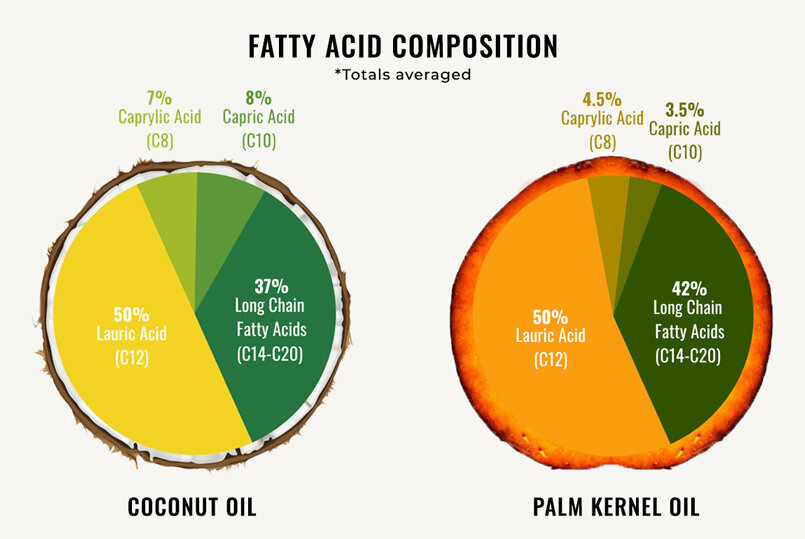COCONUT vs. PALM MCT OIL
In the edible oil industry today, MCT Oil has been taking the market by storm offering noticeable health benefits and pushing limits in ways the product is used in mixtures with other essential oils. Cooking use, and recently in powder form. MCT stands for Medium Chain Triglycerides. These are healthy medium-chain fatty acids that are much faster digested and assimilated into your body compared to their long-chain counterpart mostly found in vegetable cooking oil. MCTs are commonly found in Palm and Coconut Oil. Both their DNA is comprised of over 50% MCTs. Coconut containing over 80% MCTs and Palm having an average of over 50% MCTs.
MCT Composition of Coconut Oil and Palm Kernel Oil
MCT oil is a byproduct of coconut or palm kernel oil that is produced by extracting pure MCTs from the whole fruit. Both Coconut and Palm oil-derived MCTs carry the top 3 medium-chain fatty acids (Lauric, Caprylic, and Capric) but the composition of fatty acids slightly differs for each. Coconut Oil, which is widely known for its skin and hair care benefits as well as its intake benefits, is comprised of over 50% C12 Lauric Acid and 12 – 15% of C8 and C10. The dominant fatty acids in palm kernel oil are lauric acid (48-50%), myristic acid (17%), oleic acid (18%), and has very small traces of caprylic and capric acid (7%). Typical MCT Oil is comprised of nearly 60% C8 Caprylic Acid, and nearly 40% Capric Acid with just about 2% C12 Lauric Acid.
Richest Sources of C8 and C10
Caprylic (C8) and Capric (C10) acid are the most desirable MCTs due to their shorter chain length. And although Coconut Oil and Palm Kernel Oil are both rich food sources of MCTs coconut oil still has the highest percentage of Caprylic and Capric Acid making up 15 percent of its fatty acids. The fatty acids in palm kernel oil are over 50 percent MCTs with about 7 percent being Caprylic and Capric acid combined. One of the main advantages of C8 and C10 MCT Oil is that you get a high concentrated dose of MCTs that convert quickly to ketones, without having to eat big quantities of any particular food to get the same benefits.
PRODUCTION DIFFERENCES
The process in which MCT oil is produced, whether Coconut based or Palm, is called Fractionation. Other production methods include Methyl Ester Route and Winterization but, Fractionation is the method majority of producers use. There is no perfect cut of the chains during fractionation. Meaning, most products will not contain exactly 60% and 40% C10. There will always be “waste material” distributed in the 10 other MCTs (C6, C12, C14, etc.), and a catalyst or, solvent, along with water, is typically introduced during the process to facilitate the separation of chains (C8, C10). Certain solvents will yield a larger production but, those solvents can be harmful to the body like certain glycerin types and methanol.
SO WHAT’S SO GOOD ABOUT PURCHASING COCONUT-BASED MCT OIL?
It’s the sustainable and ethical buying choice.
The world is moving into a shift in buying choices of certain food ingredients to more sustainable, natural, organic health choices.
Producing Coconut oil involves the use of copra derived from coconuts which are grown on individual trees that don’t require deforestation to plant/re-plant as Asian countries such as; India, Sri Lanka, Indonesia, Vietnam, Philippines, Thailand and Malaysia are countries comprised of Coconut Palm Trees.
Palm oil’s dramatic growth has occurred for good reason. Palm oil is currently the most efficient vegetable oil crop in the world. While one hectare of land can produce just 0.38 tons per year of soybean oil, 0.48 tons of sunflower oil, and 0.67 tons of rapeseed oil, that same hectare can produce more than 3.7 tons of palm oil.
High yields and low land requirements, then, make palm oil the least expensive vegetable oil in the market. Palm oil is also versatile, as it is readily usable for baking, frying, soaps, cosmetics, and biofuel. In contrast, most other vegetable oils require hydrogenation for some food uses.
How can Coconut MCT compete with Palm MCT?
In the same game as palm kernel MCT, by price and by educating consumers.
In some countries such as the Philippines, Sri Lanka, and Indonesia, which are major coconut oil producers, steps are being taken to introduce a more competitive product into the international market. Simplifying the production process by turning to a more physical means of extracting MCTs (Methyl Ester routes, Physical processes) that don’t incorporate the use of harmful solvents. Going organic and producing an all-natural MCT Oil. More direct communication of factory-to-farmers is being more readily available for Local Coconut Farmer’s assistance which would allow lower prices of raw materials (coconuts) to be used in producing the same quality of product at a competitive price and able to provide equal and financial benefits to our Coconut Farmers.
Coconut-based MCT has dominated the primary medium-chain triglycerides source over the past few years. Palm kernel oil is also used as an important raw material source, and today it accounts for almost 34% of MCT oil production.
SO WHAT DRIVES THE BUYING DEMAND OF PALM-BASED MCT OIL?
Simply put, price. Looking back into the production of MCT oil when we start with Coconut oil and Palm oil. Coconut oil by itself has an average market price ranging between 1.00usd to 2.00usd/kg whereas average prices of Palm oil are well below 1.00usd/kg (0.20 – 0.50usd/kg).
Incorporating Palm oil as a raw material into producing MCT oil you have a final product that is cheap and typically has the same 60/40 C8:C10 respectively, as a coconut-based MCT product. Color, taste, health benefits are also the same as the benefits that you receive through C8 and C10 are universally the same.
Not only does a single coconut contain more healthy MCTs than a pound of Palm seeds. Coconuts are also known worldwide for its many health benefits and the many products that can be made such as; Coconut oils, Vinegar, Water, Milk, and Sugar. Palm fruit oils and palm kernel oil are high in saturated fatty acids (LCTs) and Industrial trans-fatty acids (TFAs), and esterified with glycerol. According to the World Health Organization, evidence is “convincing” that consumption of TFAs may also increase the risk of Alzheimer’s disease and certain cancers, and worsen insulin sensitivity, thereby increasing the risk of type 2 diabetes.
This production of Palm oil comes with a price as international awareness was created to address huge issues of deforestation, land grabs and global warming in 2004. Lack of global standard regulations allow Palm oil producers to grab a huge edible oil market share and continuously push for expansion by deforestation and un-ethical land grabs from native indigenous tribes and local wild life.
Frequently pitting plantation owners holding government concessions against native inhabitants with traditional land tenure. And if palm oil consumption continues to grow, as much as 15 million additional hectares of land, equivalent to five times the size of Belgium, will be needed by 2050.
With incorporating a versatile product such as MCT Oil into their daily routine. People have to look beyond the “basic” information and go into the chemistry of the product. As important as it is for customers to be looking at ingredients under the Nutrition Facts label of their typical grocery store products. The same has to go to understanding how a product like MCT is produced, what ingredients are involved, how it impacts them individually and globally; by purchasing this product how am I contributing to better care for our planet.
Sources:
Adrian Hernandez, Founder/CEO IRIE-Coco. Pioneer of Coconut Products and Coconut Bi-Products.










